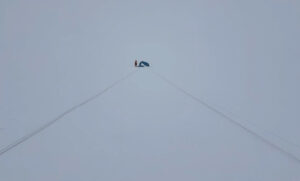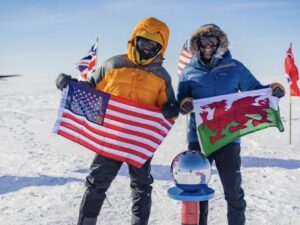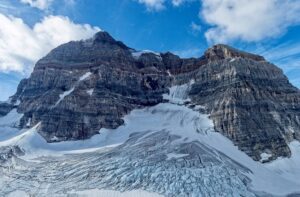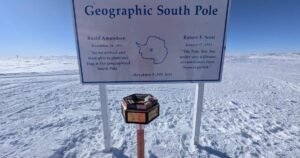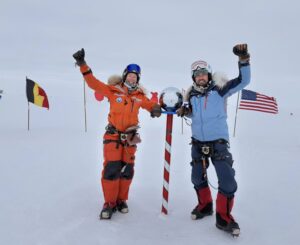Sebastian and Mark George, one of only two teams, will attempt to ski (and snowshoe, swim, crawl, sled-row) to the North Pole: “a mission that many had written off”
“The recent spells of “heat waves”, the new record set by 2016 for global temperatures, and the inauguration in the US of a climate denier gives this season a grave note,” Sebastian Copeland told Explorersweb/Pythom. “The high cost of re-engineering transport and S&R also makes this a banner year for a mission that many had written off.”
Since he traversed Antarctica in the 2011-12 Centenary Year, he and Mark George started talking about a North Pole Expedition. Determined to start from the Canadian side after Kenn Borek Air stopped supporting the skiers, Sebastian and Mark worked full-out to retain their own pilot and plane.
Not only did the logistics took up time, Sebastian also put in a lot of thought in their gear and has several pieces custom-made or altered to suite their needs, as they will attempt to do the expedition unassisted (no resupplies) and unsupported (no kites).
Last year, men and gear were tested when they trained in winter in Iqaluit, Canada, and August/September in Australia’s Simpson Desert. According to their research, their 650 km across the Simpson is the Longest Longitudinal Crossing of this desert on foot, and unassisted. [Ed: AdventureStats does not keep record of Desert Expeditions.] They had no outside assistance and carried what they needed in the trailers they pulled for 26 days over 1,100 dunes. (Here is an article that Sebastian wrote about the trek.)
Sebastian and Mark plan to arrive in Resolute Bay on February 24th and, weather permitting, hope to get out as early as possible. “If a weather window opens as early as Feb 27th, we will take it,” Sebastian told us.
We caught up with him in Los Angeles to find out more about the North Pole insurance issue, how they will handle the high humidity and cold, as the sun hardly sets in February, with little fuel rations per day as an unassisted team. He also tells who will do their weather forecasts and surface reports, and explains the difference between a North Pole and South Pole expedition, and more.
Explorersweb/Pythom: Estimated days on the ice? Sled weight?
Sebastian: This is all determined by the conditions (wind, open water, pressure and rubble), but we are hoping for 50 days and planning for 55 with emergency food and fuel for 60).
Explorersweb/Pythom: Do you have a cut-off date for arrival at the North Pole?
Sebastian: There is some flexibility, but the fast onset of the spring thaw puts the cut off around May 10
It is basically impossible to get NP S&R insurance. Did any insurance company give you insurance, or did you have to pay money upfront?
Sebastian: I have SAR insurance through GEOS; as I understand it, they cover North Pole up to $100,000. I have Medivac through Travel Guard, per usual.
Tell us about your team mate please. How did you hook up? You were both doing expeditions in the 2011-12 Centenary season. Did you meet then?
Sebastian: Mark George and I met by chance at the South Pole in 2012 [January]. Mark had just completed a solo coast-to-the-pole, unsupported trip; I was on my way to complete a transcontinental crossing from Novo to Hercules via POI and GSP. I was waiting for wind at the Pole and Mark and I hit it off. We stayed in contact and started discussion on an unassisted [no resupplies], unsupported [no kites] to the NP. Mark works in finance, but he is a great athlete and thirst for adventure from mountains to kayaks, and the ice.
You trained in Iqaluit (was it with Matty McNair, or on your own?) And you did the desert crossing. Tell us about your training program please?
Sebastian: Mark and I trained in Iqaluit last winter on our own. Mostly to test some new gear (notably a new sledge system) and get to know each other. We also crossed the Simpson desert unsupported last August. That was a 26 days / 650 km sufferfest, at the other end of the spectrum: water and heat was the challenge. We crossed almost 1,100 sand dunes pulling carts weighing 400 lbs at the start. Basically a donkey job.
Now, training is high intensity circuits; cardio; and the good ol’ tire pulling sessions!
A desert expedition is in many ways different from an ice field, but what have you learned in the desert that can improve you North Pole expedition?
Sebastian: The two are very different on the surface, but share more similarities than you would think. The obvious: the unsupported distance, and the planning that goes accordingly. In the Simpson, gravity was the mind twister: sinking tires in hot sand = no fun! But the head game is similar to the ice: the physical part is eventually eclipsed by the mental edge. Besides, both environment involve pulling heavy tow with basically the same harness. The difference is, in the desert you can take a nap in the middle of your day (when the sun is at the apex). Not so on the ice: standing is cold!
The Arctic melt was in the news lately. Who will do your weather and surface condition reports? How does your route, in particular the start point look at the moment? Are you heading for Ward Hunt Island or Cape Discovery? Or will you decide when you see the latest condition of the ice?
Sebastian: I work with the NSIDC and the NASA Goddard for current ice conditions (oscillation and wind). Weather is Mark De Keyser at World Wide Weather, per usual. So far, the wind has been pushing the pressure against Ellesmere, so the first 200km or so look promising. So far! That could change by the time we leave, but we don’t anticipate open water in the pressure against the continental shelf and leads should be kept reasonable for the start. This will change as we push north and advance in the season. We are planning for Ward Hunt right now, weather permitting. There is a hill just south of the airport that casts a shadow onto the air strip, which could make visibility more challenging at WH, but that would be our first choice. Discovery is about 65km away so we can do a fly by and the pilot will decide.
You have done a significant number of miles to the NP before. How do you handle the high humidity on the Arctic Ocean?
Sebastian: I did the last five degrees in 2009, so about 555km (plus an estimated 100km of drift). Humidity (you are at sea level), and the low angle of the sun is what separates Arctic sea missions from, say Greenland or Antarctica. It makes NP missions that much more challenging. Unassisted missions must contend with low fuel consumption for weight, so you don’t have the luxury of drying things out for long inside the tent. Basically, there is a lot of clenching teeth with damp clothes. You hang them inside the tent when the stove is on, but that rarely does the job. After that, it’s cozzy-ing up with all the damp stuff inside the VP liner of the sleeping bag next to you… That’s all I got!
How much fuel do yo have per day?
Sebastian: We are hoping to get away with 1/2 liter/day for the both of us. I have a very efficient double-walled cooking pot designed to save fuel for melting ice. We will bring some extra fuel for the start of the mission (when the temps are typically colder) and keep a close watch on consumption, hoping to settle on 1/2 liter.
How does a North Pole expedition compare to a South Pole expedition?
Sebastian: They are inherently different. SP missions are tough, but there is a lot of precedence, and you are well supported, in polar expedition terms. These are mostly well travelled routes that ground vehicles practice. And air support is generally predictable—weather aside. The challenge is the altitude, but the risk to personal safety is mitigated by the logistical operations, from ALCI and ALE to the South Pole station itself. Besides, you travel in the summer when the sun approaches its apex and the air is very dry. Bottom line: you can hang out in your underwear inside the tent and sleep outside your bag sometimes given the greenhouse effect. It gets toasty in there!
Additionally, the sun allows for solar charging, which is not the case in late winter/early spring up North. On the Arctic sea, you are incredibly exposed and vulnerable and rescue is uncertain. The ice is moving under your feet at the whim of the wind, tides and currents. It breaks and reforms, creating open water channels (called leads) and pressure ridges, which are basically walls of ice reaching up to 15 feet in places. The humidity is always a factor and the weather incredibly changing.
Besides, there are complex systems resulting from the motion of the broken ice in the summer which refreeze as fields of rubble—not fun when you are pulling heavy tow. Should something nasty happen, a plane may not be able to land anywhere near you, given the condition of the ice. And given the remoteness of the base in Resolute, it could be days before a plane reach you, given the changing weather.
If this were not enough, once the stove is turned off, the temperature inside the tent reflects the outside temperatures more or less. Frost build on the inside walls of the tent contributing to more dampness. Brrrr. The low angle of the sun on the zenith makes solar charging futile, which means more battery, and more weight…
Finally, there is always this nagging feeling that you might run into the apex predator of the white furry kind—or worse, be surprised in your tent with a visit! In polar terms, and by most metrics, all this makes the North Pole the most challenging terrestrial expedition to date.
Gear:
Skis: Rossignol BC 70’s with three pin bindings.
Are you taking snowshoes? Yes: MSR Lightning Ascent with custom straps.
Sled: brand, and one or two sleds? I am very excited to be using Thomas Ulrich’s Beluga sledges (two each). Mark and I tested them last year in Iqaluit and I am very satisfied with the result. They are expensive, but well worth it. And Thomas is a gem.
Sleeping bag: Nemo’s Canon.
Down jacket: Custom made by my longtime sponsor Napapijri, as is all the outerwear.
Drysuit: Brenig; I customized a fitting to wear skis with the dry suit on, for sketchy freshly refrozen leads. I fell through the ice in 2009. I would like to avoid a redux, if at all possible!
Tent: Hilleberg Keron 3 GT. It was a reluctant choice over the lighter Nammatj 2GT, which I used last time. Mark has a contention with polar bears (!) and the Keron has entries on both vestibules in case of a nasty surprise during the night…
You have become a dad the past few years. How does that influence the way you handle an expedition?
Sebastian: I see this as already the single greatest challenge of this expedition. I have two little girls (8 months and 2.4 years) and I miss them already. My heart aches when I think of being separated from them for two and half months. My eldest is such a fire cracker, and we are real buddies already. She is so much fun. As they say, you don’t know the meaning of love until you have a child. Being separated from my family this time has brought a different dimension to my work. Ironically, the tenor of the trip—the consequences of climate change—has much to do with their generation.
Personals: hometown, family, favorite book/movie/food, when you not plan an expedition, what do you do?
Sebastian: I live in Los Angeles but I am British from my mother and French from my dad. I moved to the US 34 years ago. I am not much of a foodie: I eat the same food everyday, except for dinners. I read mostly non-fiction books. Recent favorite: Wild by Nature by Sarah Marquis; Into the Silence by Wade Davis; and anything by Jack London.
Honestly, I always feel behind the eight ball, but when I don’t work, I play with my girls and hang with my amazing wife. Aside from expeds, I work on books, films and I travel and speak around the world on systemic transformations in the polar regions and their geopolitical consequences. (OK, If I can orchestrate it: any time spent on the ocean reminds me what freedom should feel like. I wish I could do a mountain again, but time…)
Sebastian’s book in Pythom Market: Arctica: The Vanishing North
Expedition Website and Tracker (Dispatches stream on pythom.com)
2017 Ski North Pole Expedition List by Explorersweb/Pythom
As for Polar expeditions, Sebastian Copeland skied the last 5 degrees of Latitude to the North Pole with Keith Heger in 2009, then, a year later, Sebastian and Eric McNair-Landry set a 24-hour kiting Polar World Record in Greenland when they kited over 2,300km from South to Northwest (Qaanaaq), covering 595 km in 24-hours. I, and in the 2011-12 season on Antarctica, he and Eric traversed Antarctica from Novolazarevskaya via the Pole of Inaccessibility and Geographic South Pole to Hercules inlet (3,620 km in a straight line between the 4 waypoints; 4,100 km recorded on their GPS tracker.)
The last successful North Pole expedition, 2014
North Pole success: Ryan Waters and Eric Larsen arrived at the 90ºN!
ExWeb interview with Ryan Waters, “the North Pole is like going into battle”
Must-Watch: ’Melting: Last Race to the Pole,’ an Animal Planet show
Note: A North Pole Ski expedition covers the full distance between land (Canada/Russia/Greenland) and the Pole, no flying part/most of the route. A solo claim has to be unassisted, therefore no supplies carried by pilots or vehicles drivers, or anything (food, fuel, etc) received from any person along the way. A solo person may be wind supported (kites/sails). See AdventureStats.com for Rules of Adventure and Polar Statistics.
The distance from Land to Pole is calculated in a straight line from where the skiers start. What is not added to this distance, are all the detours around high ridges, hummocks, ice blocks, rubble, thin ice, or leads (open water). Also not added, are the negative drift, and relying sleds.
Possible start points from Canada: Ward Hunt Island (775 km) or Cape Discovery (780 km) on Ellesmere Island.
Previous and Related
KK6PGW to RW0BG: Messages From Russia (Interview)
New-design Russian Amphibious Vehicle to attempt North Pole return drive
#Arctica #NorthPole #NorthPoleSki2017 #SebastianCopeland #MarkGeorge


